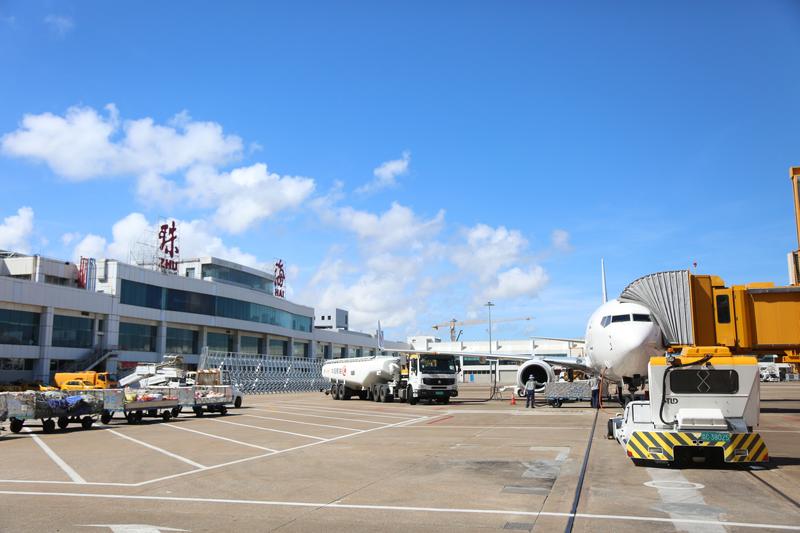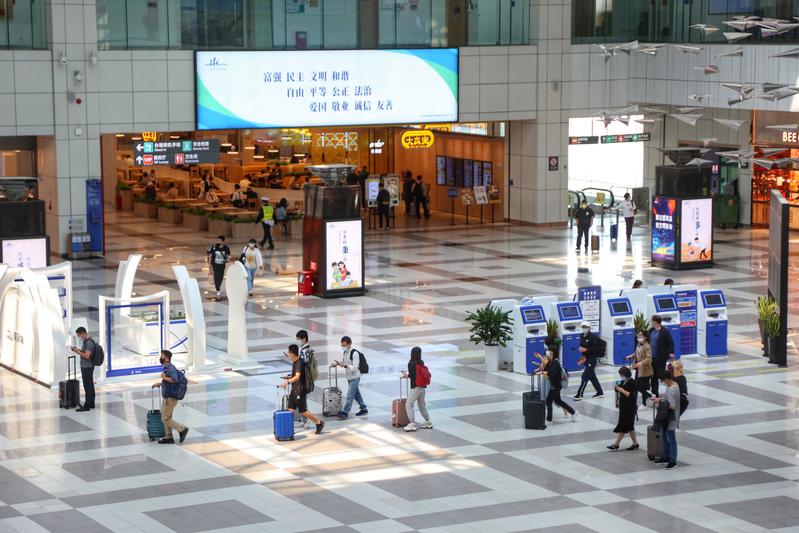Hong Kong is teaming up with other GBA cities to create the world’s biggest airport cluster. They are told to prepare for regional challenges when aviation regains popularity in a post-pandemic era. Ao Yulu reports in Hong Kong.

When the central government, for the first time, voiced support in its national Five-Year Plan for Hong Kong to enhance the city’s status as an international aviation hub, the city had just shown its enduring strength in the field as the world’s second-busiest international cargo airport in 2020 despite the impact of the COVID-19 pandemic. It shipped 4.5 million tonnes of cargo, 145,000 tonnes less than the top-ranked Memphis International Airport.
The vigorous development of Hong Kong’s aviation industry could make it a big part of the country’s vision to build world-class port and airport clusters as outlined in the 14th Five-Year Plan (2021-25). Leading the pack will be the Guangdong-Hong Kong-Macao Greater Bay Area with 10 civilian airports, five of which handled more than 10 million passengers a year before the pandemic.
This (‘GBA Airport’ alliance) will enhance the competitiveness of the region on a wider scale
Wong Wai-hung, associate professor in the Department of Supply Chain and Information Management at the Hang Seng University of Hong Kong
Local governments in the Bay Area, including the Hong Kong Special Administrative Region government and the Zhuhai and Dongguan authorities, have sped up cooperating in aviation industrial line and air cargo services, connecting the country’s domestic and global markets and facilitating the “dual circulation” development pattern.
At the same time, Shenzhen and Guangzhou, the other pillar cities of the Greater Bay Area, are eager to contribute to the national plan on aviation. In their own municipal five-year plans, the cities have set out aggressive aviation strategies, including new airport infrastructure and optimized management.
Competition is inevitable when three major cities actively explore the limits of the sky they share, but experts believe that the simultaneous presence of the three hubs in the region will not only benefit each other, but also allow them to concentrate their efforts on making the region “the largest airport cluster in the world”.
Smooth flow of goods
The close links between Hong Kong and Zhuhai in the aviation industry have a natural cornerstone: The Airport Authority Hong Kong, which operates Hong Kong International Airport, has been jointly operating and managing Zhuhai Airport under a franchise since 2006.
Two years after the Hong Kong-Zhuhai-Macao Bridge went into operation, Hong Kong Chief Executive Carrie Lam Cheng Yuet-ngor said in her 2020 Policy Address that the mega bridge will be utilized to integrate the mainland aviation network of the Zhuhai Airport with the 26 international networks of the Hong Kong International Airport, to “strengthen the competitive edge of the entire Greater Bay Area in aviation”.
A year later, she announced the setting up of a high-end aviation industrial cluster in Zhuhai in collaboration with Guangdong province. The industrial park will offer aircraft maintenance engineering services, assist in the distribution of aircraft parts and components, and promote aviation industry research and training, said Albert Yau, general manager of Hong Kong-Zhuhai Airport Management Company.
 Zhuhai Airport is strengthening cooperation with Hong Kong International Airport to better integrate the former’s mainland-focused aviation network with HKIA’s worldwide links. (PHOTO PROVIDED TO CHINA DAILY)
Zhuhai Airport is strengthening cooperation with Hong Kong International Airport to better integrate the former’s mainland-focused aviation network with HKIA’s worldwide links. (PHOTO PROVIDED TO CHINA DAILY)
In addition to basic aviation services, the industrial park will boost synergies between Zhuhai and Hong Kong in other areas such as industrial development, talent training, and resource sharing, he added.
Zhuhai Airport also intends to build a new logistics center to transport fresh food produced in Guangdong to Hong Kong and Macao or other cities covered by the airport’s flight schedules, said Yau, adding it would mean more business opportunities for the region.
“We hope to see increased cooperation in the region, making us more confident in competing with overseas airlines,” said Charles Lee, PwC’s South China (including Hong Kong) tax leader. “If we can find a junction point among the cities in the Greater Bay Area, it’s definitely good.”
In return, Hong Kong could offer professional services for both travelers and enterprises across the globe, for exported or imported goods inspection under international standards, he said.
On the other side of the Pearl River, the Airport Authority Hong Kong plans to set up a logistics park in Dongguan and an airside intermodal cargo handling facility at Chek Lap Kok. The move is in response to greater demand for cross-border logistics services as cross-border electronic commerce grows amid the pandemic.
“With the new facilities in operation, customs clearance, security screening, palletization, cargo acceptance and other services for mainland exports could be done in Dongguan before the goods are shipped to the cargo handling facility in the restricted area of HKIA by sea for air transshipment to destinations worldwide,” Vivian Cheung, the Airport Authority’s executive director of airport operations, told China Daily.
“For imports to the mainland, the goods could be directly shipped from the HKIA restricted area to Dongguan. The procedures will comply with Hong Kong’s air cargo security regulations. A pilot scheme for the operations between Hong Kong and Dongguan will be carried out,” Cheung said.
The new facilities engaging mainland cities in the Greater Bay Area help Hong Kong save transport costs and the new facilities will promote the efficiency of the logistics sector if they’re run well, said Lee, “It’ll provide more development space for logistics companies” and offer more opportunities for Hong Kong, he added.
Such a cooperation mechanism allows Hong Kong’s aviation business to play “a key dual role” in the “dual circulation” policy, Lam noted in her 2020 Policy Address. Not all cities can dream of that.
Hong Kong maintains two distinct advantages in becoming an international aviation hub, said Wong Wai-hung, an associate professor in the Department of Supply Chain and Information Management at the Hang Seng University of Hong Kong. The first is its geographical position which provides global visitors easy transit to other destinations, she said.
Located in the heart of Asia, Hong Kong is within a four-hour flight of most major Asian markets and a five-hour flight from more than half the world’s population, the 2021 Policy Address noted.
The second is its “air freedom right”, Wong continued. Under the framework of “one country, two systems” and the Basic Law, Hong Kong can independently negotiate and sign air services agreements with foreign aviation partners, offering great flexibility for Hong Kong to make use of its strength to provide more diversified air routes for air travelers and to expand cargo business.
These advantages have enabled Hong Kong to retain its position in the aviation industry, Wong said.
 Zhuhai Airport is strengthening cooperation with Hong Kong International Airport to better integrate the former’s mainland-focused aviation network with HKIA’s worldwide links. (PHOTO PROVIDED TO CHINA DAILY)
Zhuhai Airport is strengthening cooperation with Hong Kong International Airport to better integrate the former’s mainland-focused aviation network with HKIA’s worldwide links. (PHOTO PROVIDED TO CHINA DAILY)
A solution to air traffic jams
Cooperation also needs to be strengthened in other cities in the region to address long-standing problems, capitalize on potential business opportunities and achieve win-win outcomes, experts said.
There have been significant overlaps in the air routes to and from airports in Hong Kong, Shenzhen and Guangzhou due to limited airspace and flight paths, over the years, which means the cooperation cannot go deeper, said Wong.
Wong estimated that about 70 percent of the air routes in the airports in the Greater Bay Area are the same — much higher than those in Greater London or the New York metropolitan area, where less than 40 percent of the airports’ businesses overlap.
“The differentiation in the airports’ functional orientations is particularly important,” said Yuen Chi-lok, director of the Aviation Policy and Research Centre at the Chinese University of Hong Kong. Yuen added that the cooperation space of the airports will be very limited if their functional orientations overlap.
The airports within the Greater Bay Area should split up the work to prevent having too many overlapping air routes, which creates vicious competition in the industry, he said, adding that coordination should start among the region’s five busiest airports in Guangzhou, Shenzhen, Zhuhai, Hong Kong and Macao.
The Guangdong Provincial Development and Reform Commission also recognized the issue, saying in June that the airport clusters in the region have “homogenization problems in product services”, and calling for a stronger regional collaboration in an all-around way.
The division of airport businesses could also help solve the long-standing problem of congestion in the skies of the Greater Bay Area, which has caused delays in flights, he said. It’s time to start figuring out how to deal with airspace disputes amid busy airline schedules as air travel gradually picks up as travel restrictions imposed under the pandemic are lifted.
The situation is expected to improve slightly when HKIA’s third runway is completed in 2024 and speed up the efficiency of aircraft take-offs and landings in the city.
Wong has proposed the concept of a “GBA Airport” alliance that would combine the functions of the region’s major airports by strengthening coordination and connectivity. It could be the world’s biggest airport cluster if the three dominant airports - in Shenzhen, Guangzhou, and Hong Kong - are combined, and the total number of destinations served could be doubled, she envisioned.
According to statistics compiled by Civil Aviation Data Analysis, the total number of passengers using the five busiest airports in the Greater Bay Area — Hong Kong International Airport, Guangzhou Baiyun International Airport, Shenzhen Bao’an International Airport, Macao International Airport and Zhuhai Airport — had exceeded 200 million in 2018. Hong Kong alone handled more than 71.5 million passengers in 2019.
Citing London’s Heathrow Airport as an example, she said, one can now land at Heathrow Airport and easily got to another airport in the city for a second flight.
Facing an airport cluster, passengers would have more options, allowing them to make decisions based on factors such as air fares. She believes that fares will be reduced and further benefit residents and travelers. For example, it could cost a fortune to fly directly to Hong Kong, but travelers could land in another city in the region and arrive in Hong Kong through intercity transportation and spend much less.
With its wide selection of airports and quality air services, the Greater Bay Area will not only be the top choice for transit and entry to Asian countries, but also a popular tourist and business destination in its own right. “This will enhance the competitiveness of the region on a wider scale,” said Wong.
Contact the writer at aoyulu@chinadailyhk.com


